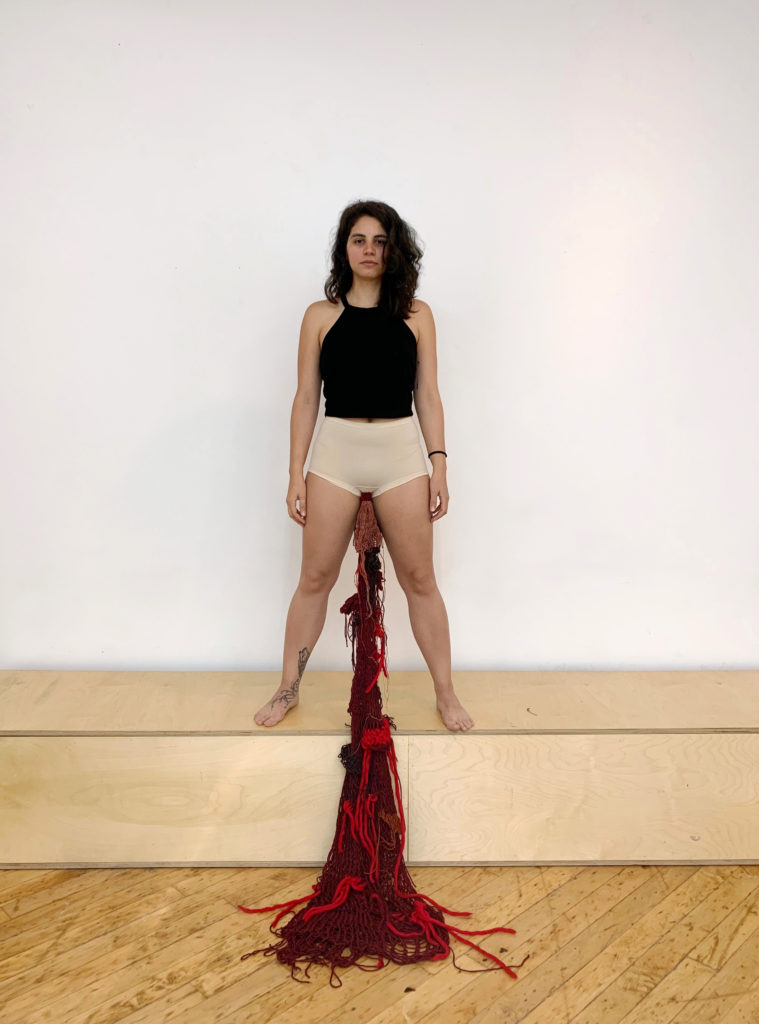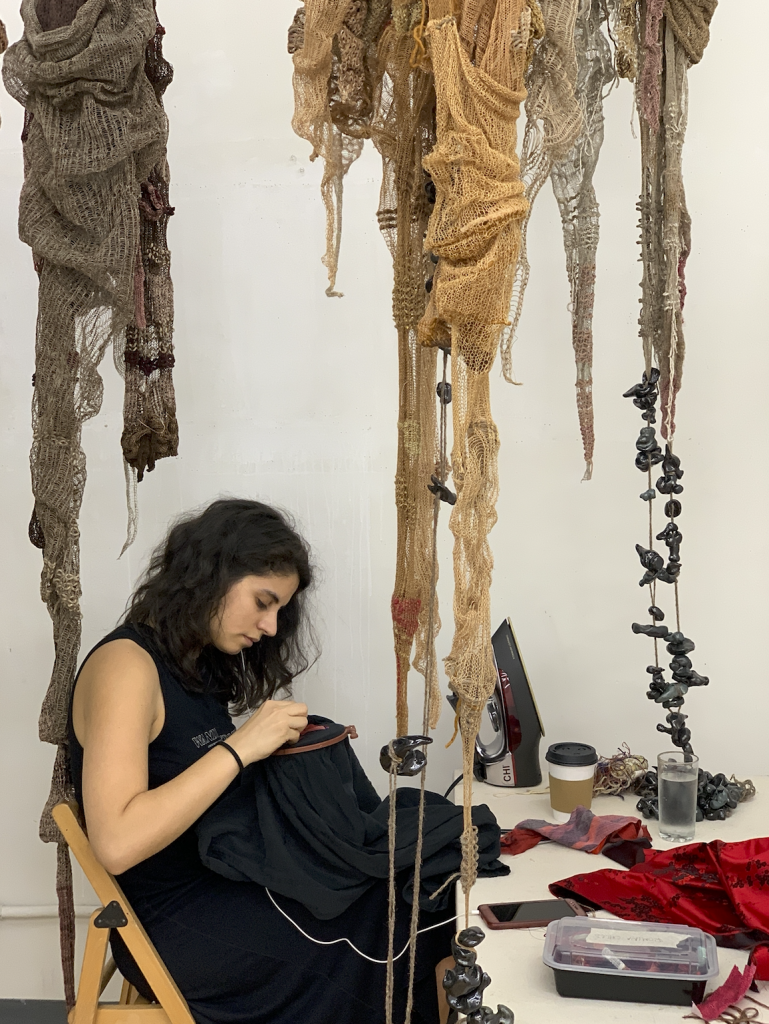AIR Artist Highlight: Romina Chuls
My conversation with artist Romina Chuls ranged from stories of her father taking her on trips in the Andes and their traditional embroidery, to ideas around the decolonization of art museums and her time in residence at TAC. To condense the breadth of our conversation into this piece, a selection of topics that we discussed are featured, along with Romina’s full responses to a few of my inquiries.
Romina is a feminist artist from Lima, Peru, and the founder of the Qué rico menstruo project which works to de-stigmatize menstruation through embroidery interventions on clothing. She went through a traditional Western-focused college arts department where she focused on painting. Moving from the two dimensional to three-dimensional sculptural practice not only moved Romina out of painting and into fiber, but also into ceramics. She is currently placing the two mediums in conversation with each other, as she is also completing a ceramic residency in tandem with her TAC residency.

The community aspect of TAC has been a refreshing change for Romina. In her university, her fellow students worked alone, with the logic that, in solitude, you would discover the true nature of your art. After her time in school, she did share a space with other artists, but they only came together to relax instead of working in an open space together. At first, she was disappointed that none of her peers had similar social, political and economic themes in their work, but it pushed Romina out of a comfortable place. New questions and explorations often come from interaction with those outside of a similar practice, and this has been invigorating to Romina's own practice.
“You all start working with the same Pre-Hispanic things, with decolonization, and it's really interesting. I love that about Latin American art because you can find these themes, but it’s refreshing to get you out of that in this place."
While at TAC, Romina noticed the influence of other artists in the residency in her work. Her experiments of screen printing on machine knitting stemmed from Erin Palumbo’s work, and the addition of stitched words in a new Qué rico menstruo garment can be traced to Winnie van Der Rijn. “I think this is enriching and makes me see things in my work that I am not seeing. I feel like creating from community is the healthier way to create.” Machine knitting has been Romina’s favorite new technique learned here at TAC. It creates volume without stiffness, and can be intermixed with woven pieces, or changed just with a difference in thread thickness. It is taking a process that is closely related to fashion and garment construction into a sculptural, fine art space.
What would you want anyone to know about you or your work?
ROMINA: They come from personal experience and I think of my work like this continuous process. I think it has a bond to the process of deconstruction from myself, understanding myself and my surroundings. So even when one piece is finished, it is because I cannot do something else to it at the moment. Or this is the point when I start messing it up instead of fixing it, so I say it is finished.
I also feel like there are so many things happening in my head with all the research that I do and force myself to do. It is really tricky for me to find the visual meaning so sometimes I approach a project with this research. I like to also be poetic enough to leave it open and for the public to contribute and have ownership in the piece in a way. The abortion piece I am working on right now, if it feels more like you don’t see the embryos as embryos, more like a weight of the day to day that pulls you. Artist is always the internalization of the artists and the public. There isn’t this truth and that sometimes that’s why I do not like to talk a lot about the piece, specifically when the public or someone is approaching the piece, to not get in the way of their personal experience.
It’s difficult because I also do all of this research but I have this image that is more intuitive. I do not know why and I can’t explain it. Like the knitting pieces with the prints. I started working on them because I said I worked with the last one as skin, so I am using skin colors. I know they look less like skin but they are working and they are saying something that I do not know yet. I like what they are saying, but I cannot describe it. Sometimes maybe because art is so conceptual right now, and my art is conceptual because it comes from conceptual research, it demands you to have an answer for each question and sometimes you don’t. Maybe it is part of the deconstruction, because of intuition you cannot explain. I think it is a conflict for me because sometimes when you do social or political themes people start to ask you more than if you just do abstract art. How is this referring to this and then they start to ask about responsibility. Not talking about the responsibility of your surroundings but of your piece. They ask that your piece does something it cannot do just as art. Also to think that art can change, that art is the revolution - it’s not, because art is in the elite sphere. It is the celebration of power because I need to sell my pieces.
What themes do you explore in your work, and what would you like to explore in the future?
Romina: I began work about the women in my family because of the masculine gaze of history. Then I got into gender themes, specifically women from Peru and Latin America and problematics with day to day. Now that I am rewriting my portfolio in English I am trying to resolve all of the ideas I have in my head. In a way, you can say I am interested in systematic violence. Also understanding the systematic violence, not only governments politics, forced sterilization or that kind of things, but also this day to day context.
Like in Peru, there is a conservative group called “Don’t Mess With My Kids” that came out because they wanted to oppose the exclusion of gender in the school's curriculum. For example, I think it was last year, they had this protest, where they put signs on the bridges that said: “it’s not your body, it is your son’s.” For a woman who is going through that, it is really violent. To actually live in this context creates systematic violence that you confront every day and to listen to the radio that no, women should not have this right or this kind of thing.
Also talking about menstruation and this shame that creates you since you are growing up, since you have your first period. I remember, I don’t know if it was that extreme, but [feeling] ashamed that people would listen to me open the package and know that [what it is], and that’s crazy. That’s like a context of some sort of violence because violence is also erasing a community language, erasing memory, creating this shame of your body.
To understand how we are submitted to this system that repeats and you don’t see. It took me to also talk about decolonization approaching Pre-Hispanic techniques. Thinking about this Audre Lorde text “For the master's tools will never dismantle the master's house.” How can you actually decolonize your way of thinking and free yourself from this structural power if you are submitted to this context?
Thinking about this Audre Lorde text “For the master's tools will never dismantle the master's house.” How can you actually decolonize your way of thinking and free yourself from this structural power if you are submitted to this context?
I think that’s what makes me find out more about Pre-Hispanic cultures. They did not have these established power structures and I think maybe by learning from them I can free myself. I am interested in learning more about Pre-Hispanic cultures from Peru, from Latin America and learn from their ways to understand sexuality, gender, this transition between gender. I just found out that Azteca women did this political protest in the street, whinging. They got together and when there was something they did not like they would just whinge. And it was so funny and so amazing because it was actually powerful, but now we understand whinging as, oh don’t be weak. Maybe we don’t actually want to deal with it. Something that is now considered for private space like, go whinge alone in your room, to actually belong in the public space.
While interest in textile and fiber arts is growing, Romina feels that Latin America is often left out of the conversations. There is a deep and beautiful history of textiles and textile practice in Latin America, and the Brooklyn Museum actually owns one of the largest remaining textiles from the Paracas culture of Peru. Learning this has not only given Romina more motivation to create, but inspiration to create outside of Peru. The community is small in Lima, but the themes and creative output are far-reaching.
New York City might offer more in terms of quantity of events, but the number can be overwhelming, and it is often difficult to choose which to go to and which to miss. The city itself can also be equally exciting and frustrating, so dynamic and energizing that it is tiring. Romina felt the city's frenetic energy appear in her music choices while creating her work. Recently, she has been listening to full DJ sets so that she is not aware of how much time is passing, wondering why the work is taking so long to do. If not this hypnotic music, it's video talks so that she is learning something while working. Sometimes, though, it can all become too much and everyone needs some silence and stillness to reset before getting back to work.
